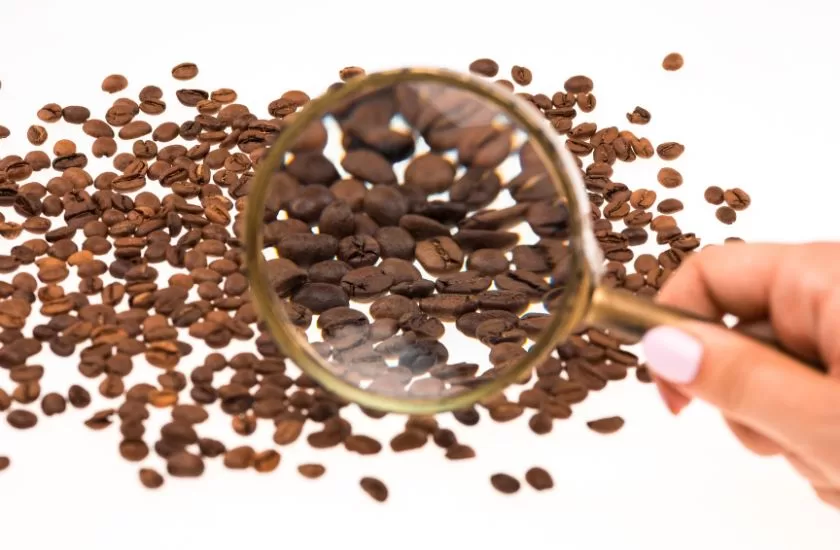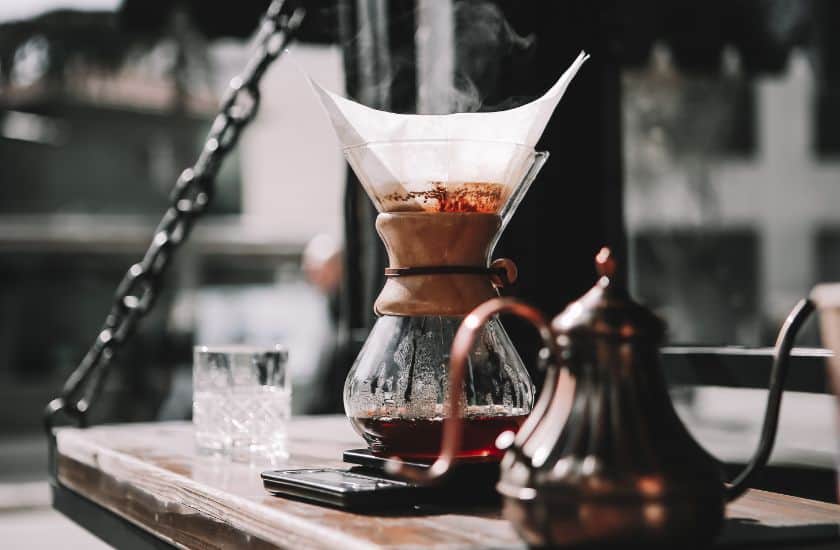The Ultimate Guide To Identifying And Fixing Bad Coffee
This post contains affiliate links, which means we receive a small commission on qualifying purchases. This does not impact your cost in any way. See details here.

Are you tired of starting your day with a cup of bad coffee?
In this comprehensive guide, we will explore what bad coffee is, how it tastes, and what causes it.
From poor quality beans to improper brewing methods, we will uncover the common culprits behind a less-than-perfect brew.
Learn how to identify bad coffee by its taste, aroma, and appearance, and discover effective ways to fix it.
Say goodbye to bitter, weak, or moldy coffee – follow our tips for a delicious cup every time.
What Is Bad Coffee?
Bad coffee can mean different things to different people. Generally, it refers to a brew that fails to deliver the desired rich taste and aromatic experience associated with a satisfying cup of coffee.
When discussing bad coffee, one of the key factors often at play is the poor quality of the beans used in the brewing process. Inferior beans can result in a lackluster flavor profile and a lack of complexity in the cup. This leads to a flat and uninspiring taste that falls short of the bold richness that coffee enthusiasts crave.
The way coffee is brewed and prepared can also contribute to a subpar experience. Improper brewing methods or outdated equipment may fail to extract the full potential of the coffee beans, resulting in an underwhelming and lackluster brew.
Ultimately, bad coffee leaves a bitter aftertaste not just on the palate but also in the experience as a whole. It fails to uplift and energize, missing the mark on what makes a truly enjoyable cup of coffee that fuels the spirit and satisfies the senses.
How Does Bad Coffee Taste?
The taste of bad coffee is often characterized by a bitter or sour flavor profile, lacking the nuanced notes and richness that define a high-quality brew.
When you take a sip of poorly brewed coffee, the first thing that hits your palate is an overwhelming bitterness that lingers unpleasantly. This bitterness can be so sharp that it masks any subtleties or depth of flavor that might have existed. The sourness, on the other hand, adds a discordant element, reminiscent of spoiled milk or overripe fruit.
These undesirable taste elements combine to create a disappointing and unappealing coffee experience.
What Causes Bad Coffee?
Several factors can contribute to the production of bad coffee, including poor bean quality, improper roasting techniques, subpar brewing methods, and inadequate water quality.
In terms of bad coffee, the quality of the beans used plays a crucial role. Low-quality beans, often lacking the rich flavor profiles and aroma of higher-grade varieties, can result in a lackluster and bitter brew. Flawed roasting processes can further diminish the coffee’s potential, as over-roasted beans can taste burnt while under-roasted ones may have a raw, grassy flavor.
Improper brewing techniques are another common culprit in the realm of bad coffee. Brewing too quickly or too slowly, using incorrect coffee-to-water ratios, or neglecting factors like grind size and water temperature can all lead to a disappointing cup.
The quality of water used for brewing also plays a significant role in the extraction process. Water that is too hard or too soft can impact the flavor of the coffee, as minerals present in the water affect how efficiently coffee compounds are extracted during brewing.
Poor Quality Beans
The foundation of bad coffee often lies in the use of poor quality beans that lack the essential flavors and aromas necessary for a satisfying cup.
In terms of coffee production, the quality of beans is paramount. Low-grade beans can result in a lackluster brew that disappoints even the most avid coffee enthusiasts. Proper sourcing of beans from reputable regions is crucial to ensure a rich, complex flavor profile. Freshness plays a major role as well; stale beans lose their vibrancy and leave a dull taste in the final cup.
Using high-quality beans not only enhances the taste and aroma but also contributes to the overall experience of enjoying a well-crafted cup of coffee. From the moment the beans are roasted to the final brewing process, every step impacts the final product, making it imperative to prioritize the quality of beans for a truly exceptional coffee experience.
Improper Roasting
Improper roasting techniques can lead to bad coffee, as under or over-roasting beans can result in a lack of balanced flavors and aromas in the final brew.
Proper roasting plays a crucial role in the world of coffee production, acting as a defining factor that sets apart exceptional coffee from mediocre blends. When beans are not roasted correctly, the flavors within the coffee can be compromised, affecting the overall experience for coffee enthusiasts.
Under-roasted beans may lack the depth and richness that come from a well-roasted bean, resulting in a beverage that falls short on complexity. On the other hand, over-roasting can lead to a burnt taste, masking the inherent flavors and nuances that the beans possess.
READ: Coffee Taste Revealed: 11 Surprising Ways Roasting Levels Impact Flavor
Stale Coffee
Stale coffee, characterized by a loss of freshness and aromatic intensity, can significantly contribute to the production of bad coffee that fails to deliver a satisfying flavor experience.
When coffee beans are not stored properly, exposure to air can accelerate the staling process. This prolonged exposure leads to the breakdown of compounds responsible for the rich flavors and aromas. As a result, brewing stale coffee can yield a lackluster cup with muted tones and a flat taste profile.
Proper storage in an airtight container away from light and moisture is essential to maintain the freshness of coffee beans and preserve their full-bodied flavors. Stale coffee not only lacks the vibrant taste but also lacks the invigorating aroma that a fresh brew offers, detracting from the overall coffee experience.
READ: How Long Do Coffee Beans Last? Read This Now To Find Out
Improper Brewing Method
Utilizing an improper brewing method, such as incorrect water temperature or extraction time, can result in bad coffee with unbalanced flavors and unsatisfactory taste profiles.
In terms of brewing a perfect cup of coffee, various factors play a crucial role in achieving a well-balanced and flavorful brew.
- Brewing methods significantly impact the overall quality of the final cup, influencing the taste, aroma, and body of the coffee.
- Water temperature is essential as it affects the extraction process, influencing the flavors extracted from the coffee grounds.
- Extraction time also matters; too short can result in under-extracted, weak coffee, while too long can lead to over-extraction, causing bitterness.
- Brewing equipment, such as the type of brewer used, further contributes to the nuances of the brew, highlighting the importance of choosing the right tool for the job.
Hence, paying attention to these details can make a significant difference in the coffee quality one enjoys.
Dirty Equipment
Using dirty equipment during the coffee brewing process can introduce undesirable flavors and contaminants, leading to the production of bad coffee that fails to meet quality standards.
Unclean equipment provides a breeding ground for bacteria and mold which can transfer their flavors onto the beans or grounds, affecting the taste profile of the final cup. Not only does the flavor suffer, but dirty equipment can also lead to health risks by harboring harmful pathogens that can make consumers ill. The oils and residues left behind in poorly cleaned machinery can taint the coffee, resulting in a brew that lacks the clarity and complexity expected in a well-crafted cup.
Using Tap Water
The use of tap water in coffee brewing can negatively impact the taste and quality of the final brew, contributing to the production of bad coffee with undesirable flavor profiles.
When tap water, which typically contains various minerals and impurities, is used to brew coffee, these elements can alter the extraction process. The mineral content in water interacts with coffee grounds during brewing, affecting the flavor compounds that are extracted from the beans. Impurities present in tap water, such as chlorine or sulfur compounds, can introduce off-flavors to the coffee, masking its true taste. This interference with the brewing process ultimately leads to a subpar coffee experience, where the nuances and complexities of the beans are overshadowed by the water’s influence.

How To Identify Bad Coffee?
Identifying bad coffee involves assessing its taste, aroma, appearance, and overall sensory experience to determine if the brew meets the desired quality standards.
In terms of taste, bad coffee often exhibits unpleasant qualities such as excessive bitterness or sourness, which can overpower the subtler flavors and nuances that make a good cup enjoyable. Upon taking a sip, if the coffee leaves an undesirable lingering aftertaste or a harsh sensation on the palate, it’s a telltale sign that something is amiss.
- The aroma of bad coffee is another key indicator. A stale or rancid smell, reminiscent of burnt beans or an overly intense and off-putting odor, can be a clear giveaway of poor quality. A fresh, properly brewed cup should entice with its inviting aroma, enhancing the overall drinking experience.
- Visual cues also play a crucial role in discerning bad coffee. If the brew appears murky, excessively oily, or has visible sediment at the bottom of the cup, it indicates potential issues with the brewing process or the quality of the beans. A good coffee should showcase a clean and clear appearance, reflecting the care and attention put into its preparation.
Bitter or Sour Taste
A bitter or sour taste in coffee can serve as a clear indicator of its poor quality, signaling potential issues in the brewing process or bean selection that contribute to the undesirable flavor profile.
When coffee beans are exposed to excessive heat during the roasting process, they can develop a bitter taste due to caramelization of sugars and oils. On the other hand, if coffee beans are not stored properly and become stale, they can acquire a sour taste, reminiscent of old or rancid flavors.
Improper brewing techniques, such as using water that is too hot or allowing coffee grounds to steep for too long, can extract bitter compounds from the beans, resulting in an unpleasant taste sensation. In contrast, under-extraction can lead to sourness in the coffee, caused by the inadequate extraction of desirable flavors.
Burnt or Smoky Aroma
A burnt or smoky aroma emanating from coffee can indicate over-roasting or improper storage, leading to the production of bad coffee with charred or harsh flavor notes.
When coffee beans are subjected to excessive heat during the roasting process, they can easily lose their delicate flavors and develop a burnt taste profile. This results in a brew that lacks the nuanced sweetness and acidity that define a high-quality cup of coffee. In addition, improper storage conditions, such as exposure to light, air, or moisture, can also contribute to the development of a smoky aroma in the beans. These undesirable scents are often a sign of deterioration in bean quality, leading to a disappointing coffee experience for the consumer.
Cloudy Appearance
A cloudy appearance in coffee can suggest improper brewing or sediment contamination, indicating potential quality issues that contribute to the overall subpar nature of the brew.
When coffee appears cloudy, it often points towards an inconsistent extraction process that can result in a lackluster taste profile. This cloudiness can stem from grounds that are ground too finely or unevenly, causing over-extraction or under-extraction. Improper brewing methods, such as using water that is too hot or cold, can also lead to cloudy coffee. If coffee is brewed using a French press without proper filtering, sediments can cloud the appearance of the final brew, affecting both visual appeal and taste.
To avoid such cloudy outcomes, ensuring proper grinding, brewing temperature, and filtration can significantly improve the overall quality of your coffee.
Weak or Watery Taste
A weak or watery taste in coffee can be indicative of under-extraction or dilution, highlighting potential flaws in brewing techniques that result in the production of bad coffee lacking depth and richness.
Under-extraction occurs when the coffee grounds have not been fully utilized during the brewing process, leading to a lack of flavor extraction from the beans. This can result from grind size being too coarse or brew time being too short, causing the coffee to taste weak. Improper ratios of coffee to water can dilute the brew, resulting in a watery taste that lacks the bold, robust flavors coffee enthusiasts crave. Understanding these factors is crucial in achieving a balanced, full-bodied cup of coffee.
READ: Coffee-To-Water Ratio: How You Can Make Better Coffee Starting Today
Moldy or Musty Smell
A moldy or musty smell emanating from coffee can indicate contamination or improper storage, suggesting potential health hazards and quality issues associated with bad coffee.
These unpleasant odors are often a sign of the presence of mold or mildew, which can develop when coffee beans are exposed to moisture or not stored properly. Moldy coffee not only poses health risks due to the potential growth of harmful bacteria but also compromises the flavor profile and quality of the brew.
Musty aromas in coffee may indicate the beans have been stored in humid or damp conditions, leading to unpleasant taste in the final cup. Consumer safety and enjoyment of coffee are greatly impacted by the proper handling and storage of beans to avoid such undesirable outcomes.
How To Fix Bad Coffee?
Rectifying bad coffee involves employing corrective measures such as using high-quality beans, proper roasting techniques, precise brewing methods, and optimal water quality to enhance the overall flavor and aroma of the brew.
In terms of fixing subpar coffee, the key lies in starting with top-notch beans sourced from reputable growers. These beans act as the foundation of the coffee’s taste profile, so selecting quality beans is crucial.
The roasting process should be handled with precision to bring out the full potential of the beans. Consistency in roasting levels can greatly impact the final flavor.
When brewing, attention to detail is essential. The right brewing method tailored to the beans’ characteristics can make a world of difference. The type of water used can significantly influence the taste. Opting for filtered water with balanced mineral content can elevate the overall coffee experience.
READ: 15 Things You Should Try Right Now To Make Coffee Taste Better
Use High Quality Beans
Utilizing high-quality beans is a crucial step in fixing bad coffee, as premium beans with rich flavors and optimal freshness can elevate the brew to a more satisfying and enjoyable level.
By selecting the finest beans, coffee enthusiasts can unlock a world of nuanced flavors, ranging from fruity and floral to chocolatey and nutty undertones.
The sourcing of these premium beans also plays a vital role in the final cup, as beans grown in specific regions or under certain conditions can impart unique characteristics.
Ensuring that the beans are fresh is equally important, as stale beans can result in a flat and uninspiring brew that lacks the vibrancy and complexity associated with high-quality coffee.
READ: The Best Coffee Beans: Do YOU Know How To Choose?
Roast the Beans Properly
Properly roasting coffee beans is essential in rectifying bad coffee, as precise roasting techniques tailored to the bean type can unlock nuanced flavors and aromas that enhance the brew’s quality.
In terms of enhancing the flavor profiles of coffee, the roasting process plays a pivotal role. Roasting is not just about heating the beans; it is a meticulous art that requires attention to detail. By controlling the temperature during roasting, the subtle nuances of the beans can be brought to light, creating a rich and balanced cup. Different beans require different roasting profiles to achieve their full potential, highlighting the importance of understanding the bean characteristics. This understanding allows for the fix of any off-flavors and the enhancement of desirable notes, resulting in a perfectly crafted cup of coffee.
Use Freshly Ground Coffee
Opting for freshly ground coffee can significantly improve bad brews, as freshly ground beans retain optimal flavors and aromas that enhance the overall taste and richness of the coffee.
When coffee beans are freshly ground, they preserve their essential oils and flavors more effectively, creating a more vibrant and full-bodied coffee experience. The process of grinding exposes more surface area of the beans to air, accelerating the oxidation and degradation of the coffee’s desirable attributes. By grinding the beans just before brewing, you ensure a fresh flavor profile that is free from staleness.
This freshness directly impacts the aroma release, giving your coffee a more pronounced and enticing scent that can elevate your entire coffee-drinking experience. The improvement in brew quality is notable as the brewing process extracts the freshest essence of the coffee grounds, resulting in a smoother, more nuanced cup of coffee that is devoid of any lingering bitterness or staleness.
Use Proper Brewing Techniques
Applying proper brewing techniques is key to fixing bad coffee, as precise methods, water temperatures, and extraction times can optimize flavor extraction and enhance the overall quality of the brew.
Temperature control plays a vital role in the brewing process, ensuring that the water is at the optimal temperature to extract the flavors without scorching the beans. Achieving grind consistency is crucial as it impacts the surface area exposed to water, influencing the extraction rate.
Attention to extraction parameters such as brew ratio and contact time with the coffee grounds is also essential. By mastering these elements, coffee enthusiasts can craft a rich, balanced cup of coffee that highlights the nuances of the beans and the brewing method.
READ: The Ultimate Guide: 7 Brewing Methods For Flavorful Fresh Brewed Coffee
Clean and Maintain Equipment
Regularly cleaning and maintaining brewing equipment is essential in improving bad coffee, as clean tools and machinery prevent flavor contamination and ensure consistent brew quality.
Proper equipment hygiene is the foundation for creating a delightful coffee experience that highlights the rich aromas and flavors of freshly brewed coffee. By keeping your equipment in top-notch condition, you fix common issues like bitterness or sourness in your brews. When you invest time and effort in cleansing and maintaining your coffee-making tools, you not only extend their lifespan but also safeguard the integrity of your coffee’s nuanced taste profiles.
From coffee machines to grinders, every piece of equipment plays a vital role in the overall coffee-making process. Regular cleaning routines and timely maintenance prevent build-up that can lead to off-putting odors or inconsistent extraction. With a keen focus on cleanliness, you pave the way for a smooth operation and a superior coffee brewing experience that delights both you and your customers.
Use Filtered or Bottled Water
Opting for filtered or bottled water can be a simple yet effective fix for bad coffee, as quality water sources free of impurities can enhance flavor clarity and purity in the brew.
When using filtered or bottled water, you eliminate the risk of unpleasant tastes or odors that tap water might carry, ultimately resulting in a cleaner and more vibrant cup of coffee.
The absence of impurities in the water ensures that the delicate nuances of the coffee beans are not masked, allowing for a true representation of the flavor profile to shine through.
The consistent quality of water from a trusted source can contribute to a more predictable extraction process, leading to a more balanced and enjoyable coffee experience.

Frequently Asked Questions
What causes coffee to taste bad?
There are a few key factors that can cause coffee to taste bad. This can include the type of beans, the brewing method, water quality, and the freshness of the coffee. Understanding these factors can help you identify and fix bad coffee.
How can I tell if my coffee is bad?
There are several signs that your coffee is bad, including a sour or bitter taste, a lack of aroma, or a thin and watery consistency. These indicators can help you pinpoint the problem and take steps to fix it.
What are some common mistakes people make when brewing coffee?
One common mistake is using the wrong grind size for the brewing method. Another is using stale or low-quality beans. Additionally, not using enough coffee grounds or using water that is too hot can also result in bad-tasting coffee.
How can I improve the taste of my coffee?
There are a few ways to improve the taste of your coffee, such as using freshly roasted beans, grinding them to the appropriate size, and using filtered water. You can also experiment with different brewing methods to find the one that works best for your taste preferences.
How often should I clean my coffee equipment?
It’s important to regularly clean your coffee equipment, especially if you notice a decrease in the taste of your coffee. For a coffee maker, it’s recommended to clean it once a month, while for a French press or pour-over, cleaning after every use is ideal.
Can I fix bad coffee that has already been brewed?
In some cases, you can fix bad coffee that has already been brewed. For example, you can dilute it with hot water or add a pinch of salt to counteract bitterness. However, it’s best to avoid these issues by properly identifying and fixing bad coffee before it’s brewed.







